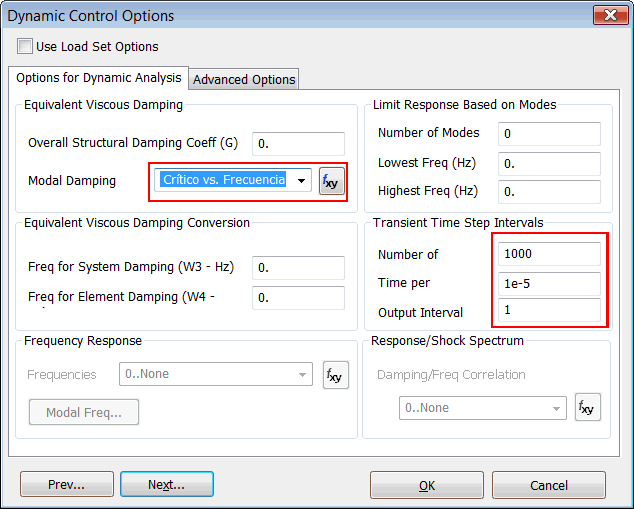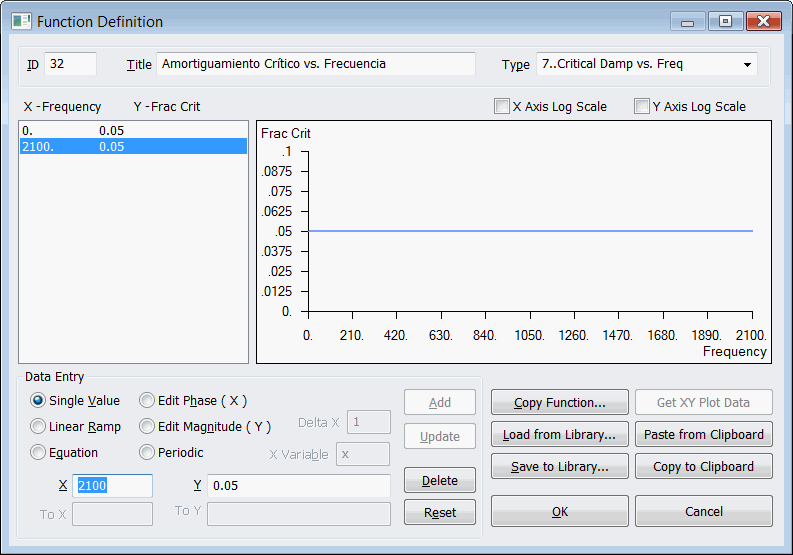BTFEA
Mechanical
- Jul 4, 2012
- 3
I am working on the frequency response analysis using Sol 111 for a large structure. For this analysis I am defining a damping value as 5% in TABDMP1 card.
But from the .f06 file I see that Nastran reads this as 10% damping using the relation G=2*modal damping (zeta). I want to know if this is ok as my intention was to use only 5% damping but it turns out to be 10%?.
In .f06 file the damping value is not printed unless otherwise there is extrapolation of the damping curve. Please see .f06 output below:
*** USER WARNING MESSAGE 7697 (GKAM1A)
ONE OR MORE MODAL DAMPING VALUES FOR STRUCTURE MODES ARE EITHER NEGATIVE OR HAVE RESULTED FROM EXTRAPOLATION OF THE
TABDMP1 1 TABLE DATA AS SHOWN BELOW:
CYCLIC FREQUENCY = 3.603621E+02 MODAL DAMPING VALUE = 1.000000E-01 (BY EXTRAPOLATION BEYOND THE RIGHT END OF THE TABLE)
CYCLIC FREQUENCY = 3.633056E+02 MODAL DAMPING VALUE = 1.000000E-01 (BY EXTRAPOLATION BEYOND THE RIGHT END OF THE TABLE)
CYCLIC FREQUENCY = 4.103652E+02 MODAL DAMPING VALUE = 1.000000E-01 (BY EXTRAPOLATION BEYOND THE RIGHT END OF THE TABLE)
CYCLIC FREQUENCY = 4.199019E+02 MODAL DAMPING VALUE = 1.000000E-01 (BY EXTRAPOLATION BEYOND THE RIGHT END OF THE TABLE)
CYCLIC FREQUENCY = 4.281735E+02 MODAL DAMPING VALUE = 1.000000E-01 (BY EXTRAPOLATION BEYOND THE RIGHT END OF THE TABLE)
CYCLIC FREQUENCY = 4.558051E+02 MODAL DAMPING VALUE = 1.000000E-01 (BY EXTRAPOLATION BEYOND THE RIGHT END OF THE TABLE)
CYCLIC FREQUENCY = 2.896406E+03 MODAL DAMPING VALUE = 1.000000E-01 (BY EXTRAPOLATION BEYOND THE RIGHT END OF THE TABLE)
But from the .f06 file I see that Nastran reads this as 10% damping using the relation G=2*modal damping (zeta). I want to know if this is ok as my intention was to use only 5% damping but it turns out to be 10%?.
In .f06 file the damping value is not printed unless otherwise there is extrapolation of the damping curve. Please see .f06 output below:
*** USER WARNING MESSAGE 7697 (GKAM1A)
ONE OR MORE MODAL DAMPING VALUES FOR STRUCTURE MODES ARE EITHER NEGATIVE OR HAVE RESULTED FROM EXTRAPOLATION OF THE
TABDMP1 1 TABLE DATA AS SHOWN BELOW:
CYCLIC FREQUENCY = 3.603621E+02 MODAL DAMPING VALUE = 1.000000E-01 (BY EXTRAPOLATION BEYOND THE RIGHT END OF THE TABLE)
CYCLIC FREQUENCY = 3.633056E+02 MODAL DAMPING VALUE = 1.000000E-01 (BY EXTRAPOLATION BEYOND THE RIGHT END OF THE TABLE)
CYCLIC FREQUENCY = 4.103652E+02 MODAL DAMPING VALUE = 1.000000E-01 (BY EXTRAPOLATION BEYOND THE RIGHT END OF THE TABLE)
CYCLIC FREQUENCY = 4.199019E+02 MODAL DAMPING VALUE = 1.000000E-01 (BY EXTRAPOLATION BEYOND THE RIGHT END OF THE TABLE)
CYCLIC FREQUENCY = 4.281735E+02 MODAL DAMPING VALUE = 1.000000E-01 (BY EXTRAPOLATION BEYOND THE RIGHT END OF THE TABLE)
CYCLIC FREQUENCY = 4.558051E+02 MODAL DAMPING VALUE = 1.000000E-01 (BY EXTRAPOLATION BEYOND THE RIGHT END OF THE TABLE)
CYCLIC FREQUENCY = 2.896406E+03 MODAL DAMPING VALUE = 1.000000E-01 (BY EXTRAPOLATION BEYOND THE RIGHT END OF THE TABLE)


